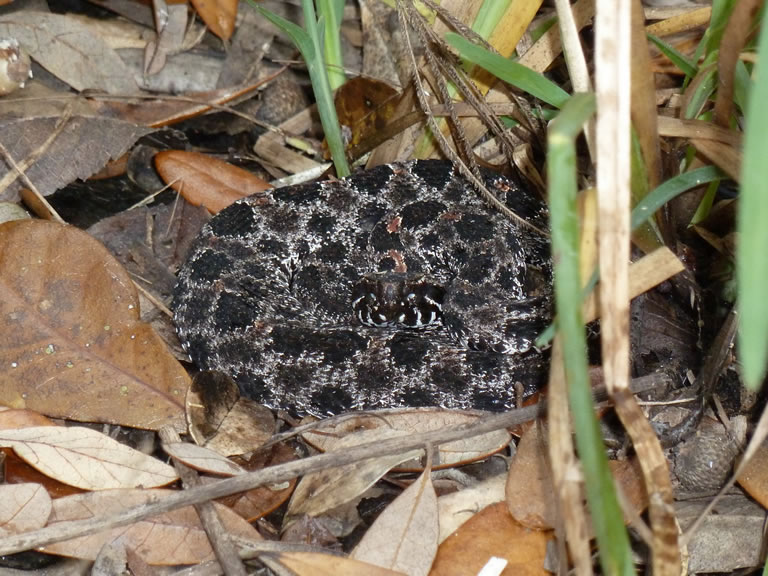“Pigmy rattlesnakes are everywhere around here,” people keep telling us as we volunteer on Lake Woodruff National Wildlife Refuge for the winter. But we’d yet to see one, even when we accompanied Dr. Terry Farrell, biology professor at Stetson University, and a couple of his research students searching for pigmies a few weeks ago.
New Search
But that was unusual, Dr. Farrell told us then. They generally locate pigmies on the Hammock Trail, one every hour and a half on average. So when we were once again invited to accompany Dr. Farrell, along with Stetson researchers and a group of students from Rockford University, we joined in with great expectations.
This time the trail was muddier than our previous excursion. Standing water throughout the hammock we entered was the result of recent rains. But, as Dr. Farrell indicated before, flooding tends to drive the pigmies into the open. And this proved to be true when one of our group immediately discovered one of the snakes coiled next to a cabbage palm.
Tubing the Snake
Post-doctoral candidate and assistant professor at Stetson University Craig Lind readied equipment to “tube” the snake – a process that allows safe handling for the snake as well as the handler – and withdraw blood. After earning his PhD studying how environmental variables affect hormone production in snakes, Dr. Lind is focusing on stress hormones and immune functions. “Every snake we picked up out there has sores on them,” he later said, “fungal disease, particularly in the winter.”
[twocol_one]

[/twocol_one] [twocol_one_last]

[/twocol_one_last]

“It’s from the environment,” said doctoral candidate Sarah Smiley. “When it’s cold – especially when it’s wet – they’re unable to fight it off. It can kill them, especially if it gets to their head.” When Dr. Lind finished his work with it, Sarah slid the snake from the tube into a collecting bucket to take it to the University for further studies.

Collecting Trash and Finding Snake
An aluminum can squashed in the mud a ways off the trail attracted my attention, and I tiptoed over the thick mire toward it, stepping on fallen branches and tree roots along the way to avoid sinking to my ankles. Biologists, I thought, suffered through a lot of unpleasant conditions to accomplish their goals! After finally retrieving the can, as I twisted around to return to the trail, I spotted a small tightly-coiled, well-camouflaged form resting on a palm frond with a large leaf arched over its body. “Found one!” I hollered to others, sounding a bit like a child on an Easter egg hunt.
Because it was elevated a bit, this pigmy rattlesnake was in a good position for biology student Ethan Royal to set up his camera and record its feeding reactions. For that reason, this snake would not be tubed and examined.
More Pigmies
But as the group spread out through the hammock, three other pigmies were located, tubed, examined, two of them placed in the collecting bucket. A couple hours in the hammock had proved quite successful.
And now it was time to return to the lab, along with the three pigmies, to continue studies and research that we can’t even begin to comprehend. But we will jump at the opportunity to accompany these professors and students whenever they return to the field to resume their search for more pigmy rattlesnakes.




Nice job on that.
Thanks, Joshua! Although that species of rattlesnake doesn’t occur in your part of Arizona, your state has more species of rattlers than any other state! Now is the time of the year when the snakes will start coming out of hibernation, so be sure to watch where you put your hands and feet!